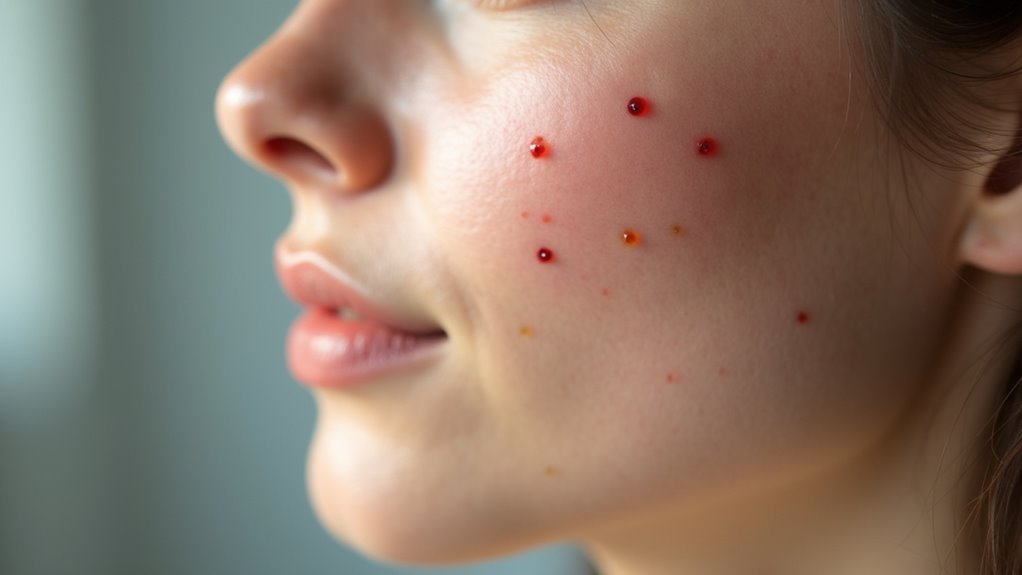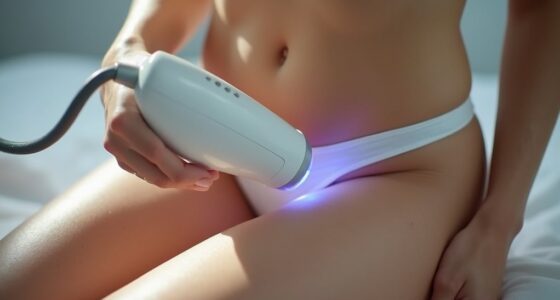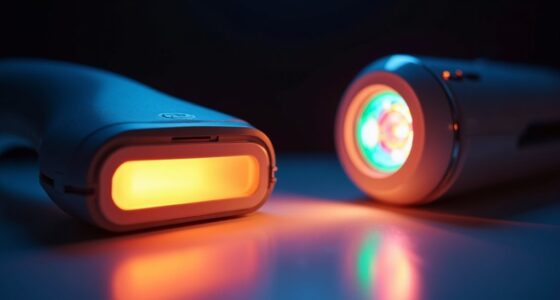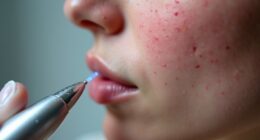At-home laser devices can help reduce cherry angiomas if used carefully and correctly. They work by targeting blood vessels in the skin, but proper device selection and application are essential for safety and effectiveness. Keep in mind, results may vary, and multiple treatments might be necessary. If you’re interested in safer methods, precautions, and expert advice, there’s more to contemplate before starting your DIY laser journey.
Key Takeaways
- At-home laser devices may reduce cherry angiomas if used correctly and with appropriate device selection.
- Proper technique and safety precautions are essential to avoid skin damage during DIY treatments.
- Results typically appear after multiple sessions, but complete removal may require professional intervention.
- Devices like IPL, diode, or pulsed dye lasers can target superficial blood vessels associated with angiomas.
- Consulting a healthcare professional before use ensures safety and proper diagnosis of skin lesions.
Understanding Cherry Angiomas: What Are They?
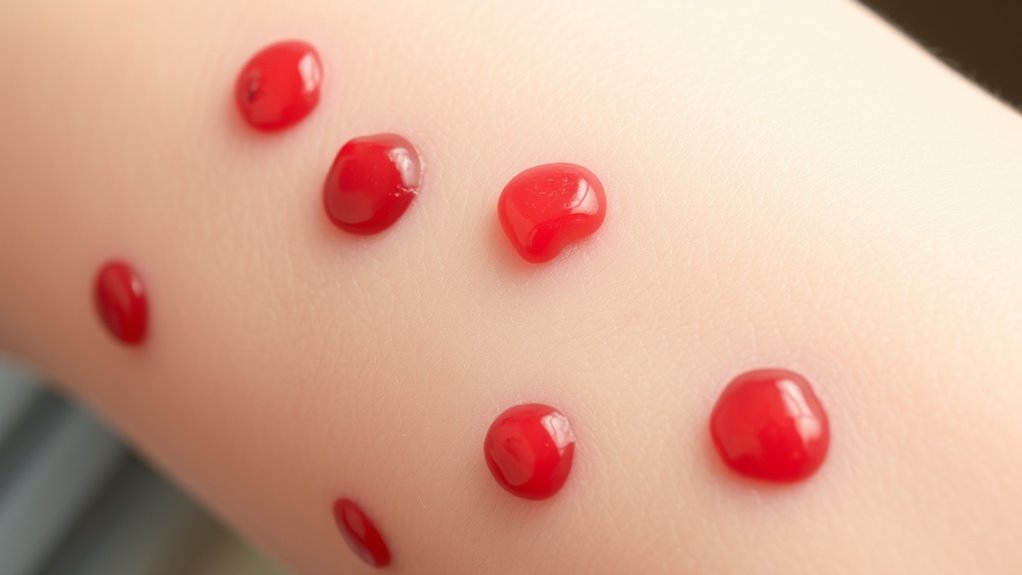
Have you ever noticed small, red bumps on your skin that seem to pop up out of nowhere? These are cherry angiomas, common benign skin growths that often raise cosmetic concerns. They typically appear as bright red or purple domed spots and can vary in size. While harmless, many people seek treatment because of their appearance and potential impact on skin pigmentation. Cherry angiomas are caused by an overgrowth of blood vessels in the skin, leading to these distinctive red bumps. Understanding what they are helps you determine if they require removal or if you’re comfortable leaving them alone. Although they’re not dangerous, their appearance can affect your confidence, especially if they’re in visible areas. Knowing more about cherry angiomas helps you make informed decisions about treatment options. Using appropriate treatment methods, such as laser therapy or cryotherapy, can effectively remove or reduce their appearance if desired.
How Do Laser Treatments Work on Skin Growths?

Laser treatments target cherry angiomas by delivering focused light energy that selectively destroys the abnormal blood vessels responsible for their appearance. This process heats and coagulates the vessels without damaging surrounding skin. During treatment, the laser’s light may also affect skin pigmentation, leading to temporary changes like darkening or lightening of the skin. If you have cosmetic tattooing or uneven skin pigmentation, inform your provider, as laser energy can alter these areas. The key is precision—modern laser devices target only the unwanted growths, sparing healthy tissue. Here’s a quick overview:
| Feature | Effect |
|---|---|
| Targeted Light | Destroys abnormal blood vessels |
| Skin Pigmentation | May temporarily change color |
| Cosmetic Tattooing | Could be affected by laser |
| Healing Time | Usually quick, minor side effects |
| Effectiveness | Usually permanent after few sessions |
Types of Laser Devices Suitable for Home Use
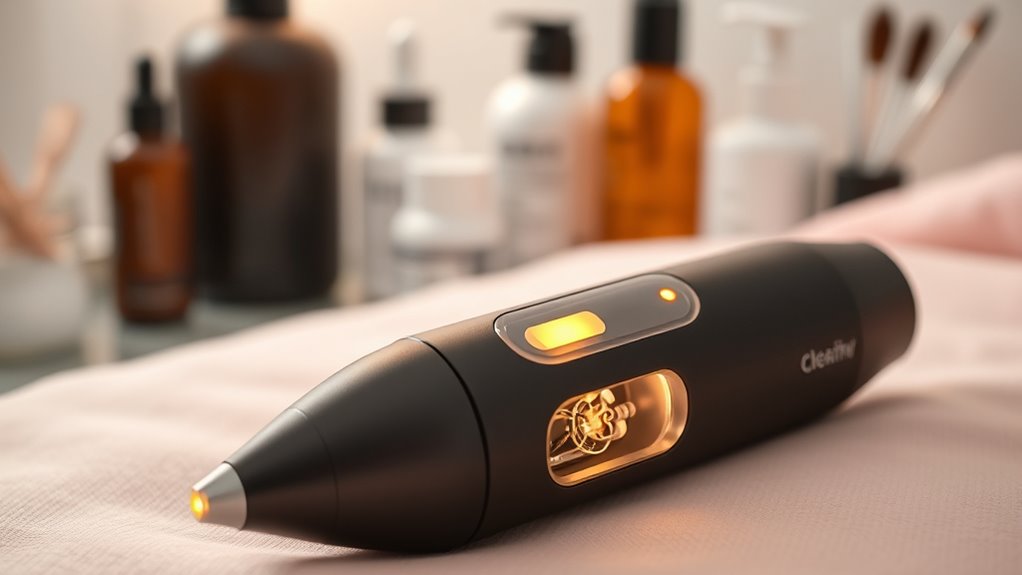
When choosing laser devices for home use, it’s important to select options designed specifically for non-professional settings. These devices prioritize laser safety and are tailored for ease of use. Here are four common types suitable for at-home treatments:
- Intense Pulsed Light (IPL) devices – versatile and effective for various skin concerns.
- Diode lasers – often used for hair removal but can target superficial blood vessels.
- Pulsed dye lasers – designed to treat vascular issues like cherry angiomas safely.
- Nd:YAG lasers – powerful, but less common for home use due to complexity.
Additionally, selecting a device with appropriate horsepower levels can improve treatment efficacy for vascular skin concerns. Always prioritize device selection based on safety features and proper instructions. Remember, choosing the right device is *essential* for safe, effective treatment and minimizing risks.
Effectiveness of At-Home Laser Devices on Cherry Angiomas
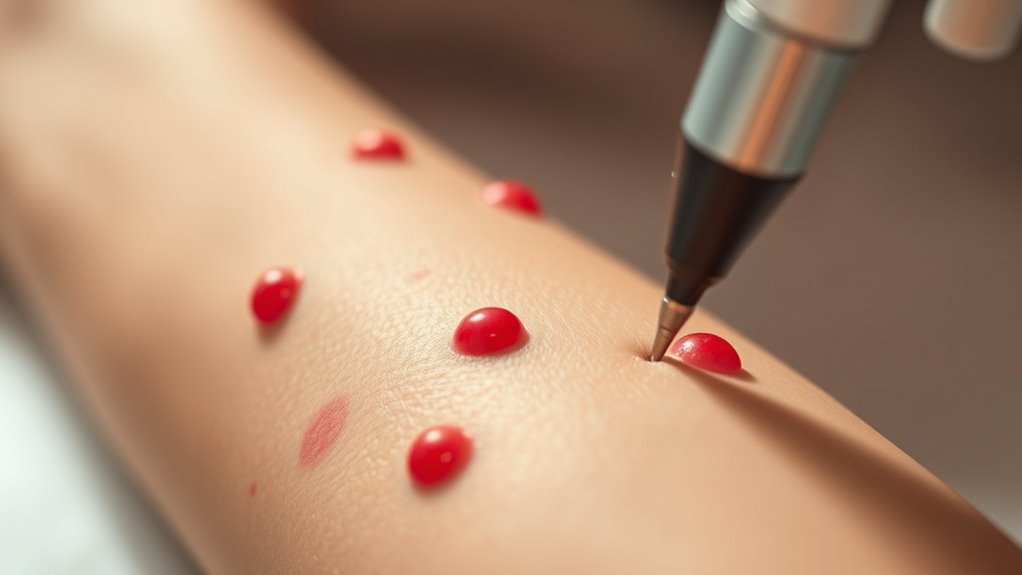
At-home laser devices can effectively reduce cherry angiomas, but their success depends on proper use and individual skin response. You’ll see results if you follow instructions carefully and choose the right device. When considering effectiveness, it’s helpful to do a cost analysis, comparing device prices and potential savings over professional treatments. Keep in mind, device maintenance is essential; regular cleaning and proper storage ensure peak performance and longevity. While some users notice improvements after a few sessions, others may need more time or multiple treatments. It’s important to set realistic expectations and be consistent with your treatment routine. Overall, at-home laser devices can work well for small, superficial cherry angiomas when used correctly and maintained properly. Proper application techniques and understanding of device safety are crucial to achieving optimal results and avoiding adverse effects.
Safety Considerations When Using Home Laser Devices
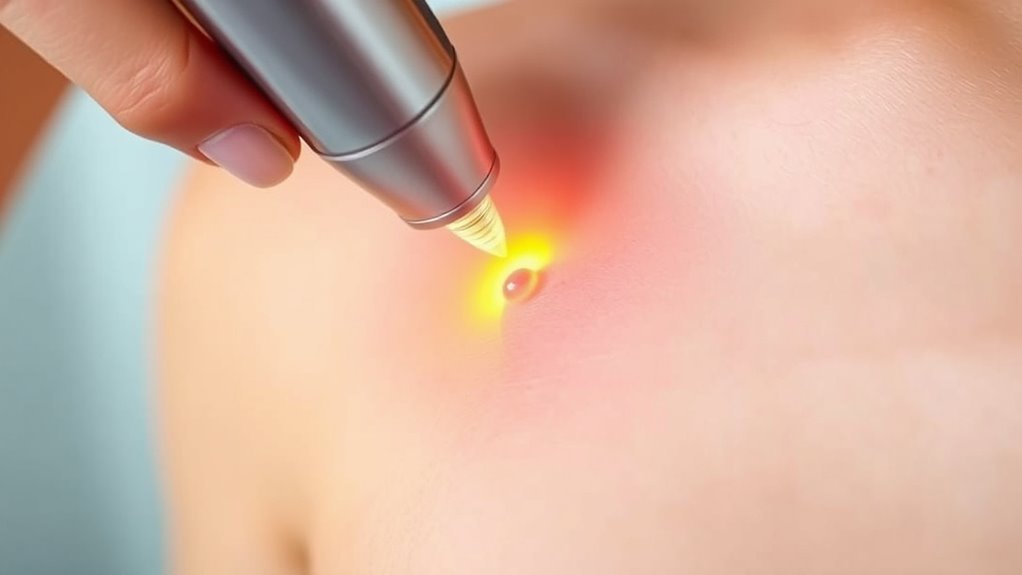
To guarantee safe use of home laser devices, it’s essential to follow all manufacturer instructions carefully and avoid shortcuts. First, verify proper device calibration before each use to deliver accurate and safe treatments. Second, always check battery safety—use only recommended batteries and avoid overcharging to prevent malfunctions. Third, keep the device clean and store it in a safe place, away from children. Fourth, avoid using the device on broken or irritated skin, and don’t exceed the recommended treatment frequency. Fifth, be aware of the types of skin conditions that may contraindicate laser use, and consult a dermatologist if uncertain. By adhering to these safety tips, you reduce risks and maximize effectiveness. Remember, proper calibration and battery safety are critical for safe, effective at-home laser treatments. Always prioritize safety to protect your skin and health.
Potential Risks and Side Effects of DIY Laser Treatments
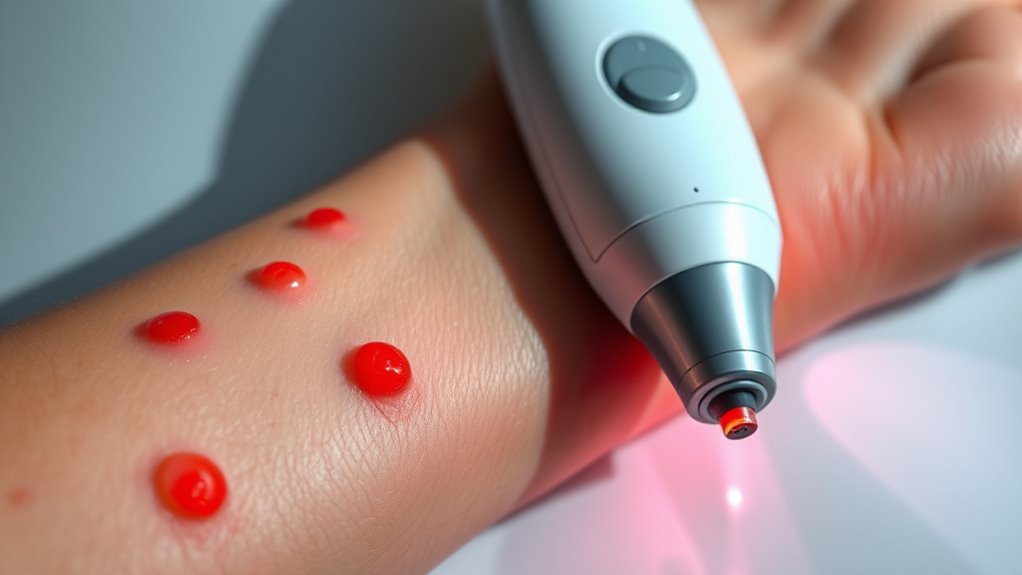
Using DIY laser devices can lead to skin damage if you’re not careful. You might also misuse the device, increasing the risk of burns or scars. Additionally, unexpected side effects like discoloration or irritation can occur if you’re unaware of proper procedures.
Skin Damage Risks
While DIY laser devices may seem like a convenient solution, they carry significant risks of skin damage if not used properly. Incorrect use can lead to burns, scarring, hyperpigmentation, or hypopigmentation. Here are some risks to contemplate:
- Burns – Improper settings or application can cause painful skin burns.
- Scarring – Damage to deeper layers may leave permanent scars.
- Pigment Changes – You risk uneven darkening or lightening of your skin.
- Delayed Healing – Skin may take longer to recover, increasing infection chances.
Skin damage risks are especially concerning if the device is used without proper knowledge of cosmetic laser safety. Although cosmetic alternatives are available, they often come with different risk profiles. Cost considerations also matter; DIY treatments may seem cheaper but can lead to costly skin damage, making professional options worth the investment for safety.
Improper Device Use
Improper use of DIY laser devices can lead to serious side effects if you’re not careful. If you skip proper device calibration or lack user training, you risk burns, scarring, or pigment changes. Misusing the device can cause uneven treatment or damage beyond the targeted cherry angiomas. It is crucial to understand how to calibrate the device correctly and follow safety instructions. Without proper training, you might misjudge settings or treatment areas, increasing risks. Always read the manual thoroughly and consider seeking guidance before use. Proper projector setup techniques can help prevent errors and ensure safer treatment outcomes.
Unexpected Side Effects
Despite the appeal of at-home laser treatments, they carry a risk of unexpected side effects that can impact your skin’s health. You might experience issues like:
- Unintended skin pigmentation changes, causing dark or light spots.
- Cosmetic concerns, such as scarring or uneven skin texture.
- Increased redness or inflammation that persists longer than expected.
- Worsening of cherry angiomas or development of new skin lesions.
These risks highlight that DIY laser treatments can disrupt your skin’s natural balance, especially if not used correctly. Even minor mistakes can result in lasting cosmetic concerns, making professional guidance essential. Be cautious and consider whether the potential side effects outweigh the benefits of at-home options. Proper understanding of toilet maintenance and repairs can help prevent complications in other areas of home care.
Comparing Professional Laser Procedures and At-Home Devices
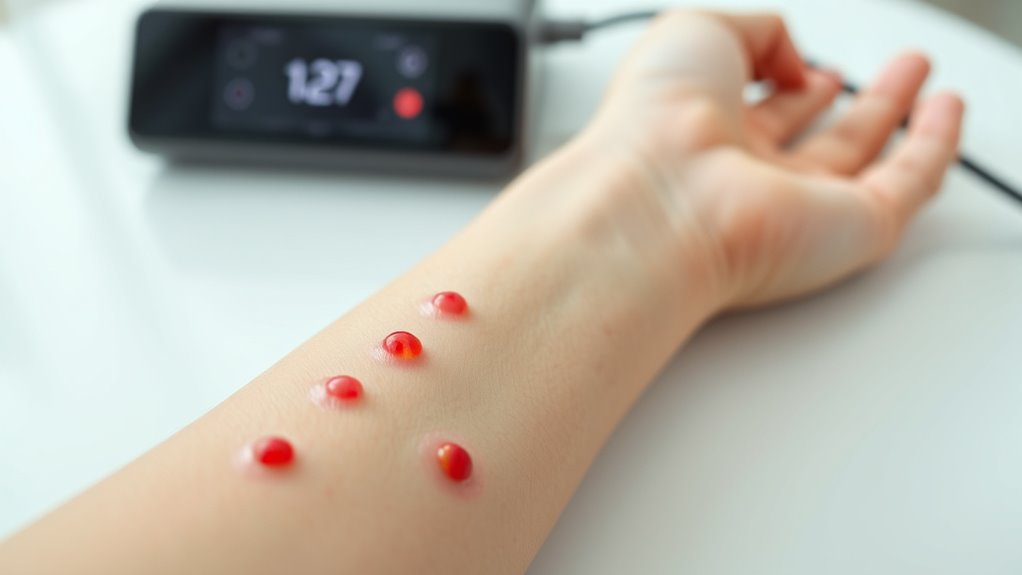
Professional laser procedures typically offer more powerful and precise treatment for cherry angiomas, but they come with higher costs and require visits to a dermatologist or cosmetic specialist. These procedures guarantee proper laser safety and device calibration, reducing risks like burns or scarring. They use medical-grade lasers calibrated for your specific skin type and lesion size, delivering targeted energy that minimizes damage to surrounding tissue. At-home devices, on the other hand, are generally less intense and easier to use, but they may lack the calibration precision of professional equipment. While at-home options are more convenient and affordable, they might not deliver the same level of effectiveness or safety without proper understanding. Proper safety guidelines and knowledge are essential when considering at-home treatments. Ultimately, professional treatments provide more controlled results, especially for stubborn or larger cherry angiomas.
Tips for Choosing the Right At-Home Laser Device
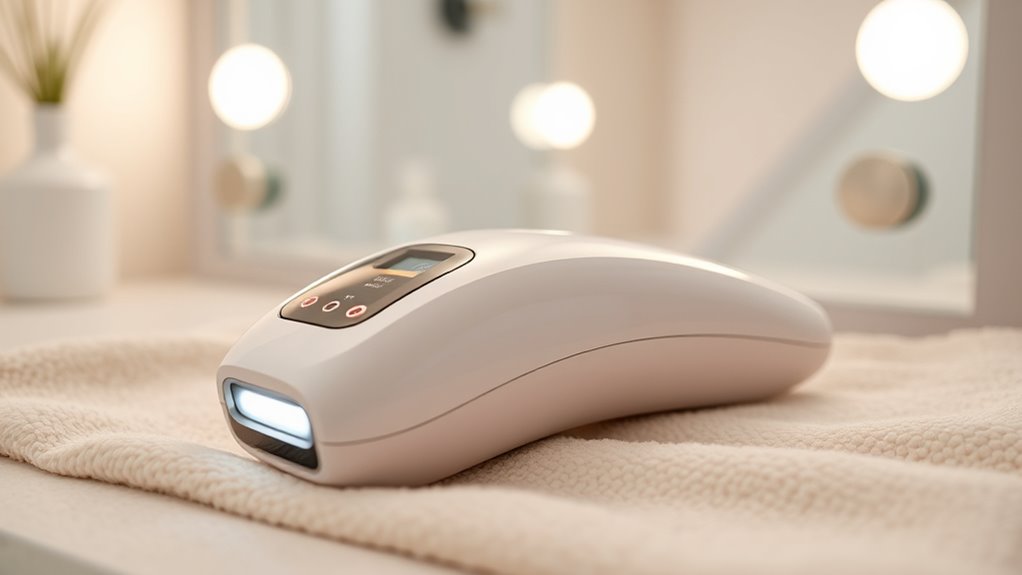
Choosing the right at-home laser device involves careful consideration of several key factors to guarantee safe and effective treatment. First, verify the device is designed specifically for DIY skincare and targets cherry angiomas safely. Second, check laser safety features, such as skin sensors and protective shields, to prevent accidental burns. Third, review the device’s wavelength and energy levels to match your skin type and condition. Fourth, read user reviews and manufacturer guidelines to gauge reliability and ease of use. Remember, prioritizing laser safety and understanding the device’s capabilities are essential. Selecting the proper device helps minimize risks and improves results, making your DIY skincare journey safer and more effective. Always follow instructions carefully and avoid rushing the process. Additionally, understanding the cultural impact of technology on artistic expression can help you stay informed about innovations in skincare devices.
When to Seek Professional Medical Advice
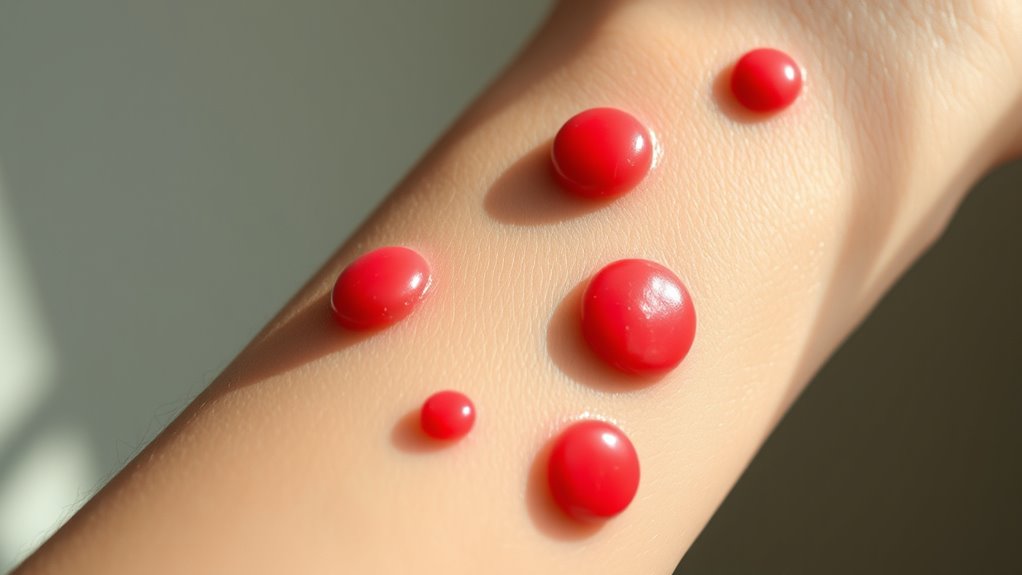
While at-home laser treatments can be effective for cherry angiomas, it’s important to recognize when professional medical advice is necessary. If your angiomas change in size, color,, or shape, or if they become painful or bleed, see a healthcare provider immediately. Relying solely on natural remedies or cosmetic alternatives might not address underlying issues or prevent complications. A dermatologist can evaluate whether your cherry angiomas are benign or require removal through professional procedures. If you’re unsure about the safety or effectiveness of at-home treatments, consult a professional before proceeding. Seeking medical advice ensures proper diagnosis, reduces risks, and helps determine the best approach—whether it’s continued at-home care or a clinical procedure for safe and effective removal. Understanding tableware and the importance of terminology can also help you communicate more effectively with healthcare providers.
Frequently Asked Questions
Can At-Home Laser Devices Permanently Remove Cherry Angiomas?
You wonder if at-home laser devices can permanently remove cherry angiomas. While they might seem convenient, there are safety concerns, especially if you’re not a professional. These devices may not be as effective or safe as medical treatments, and results vary. Also, consider cost-effectiveness—professional removal might be more reliable and safer in the long run. Always consult a dermatologist to ensure safe and effective treatment options.
Are There Specific Skin Types That Respond Better to Home Laser Treatments?
You’ll find that skin sensitivity and device compatibility play big roles in how well at-home laser treatments work for you. People with less sensitive skin often see better results because their skin tolerates the laser better. Make sure to choose a device compatible with your skin type, and always follow manufacturer instructions. If you have sensitive skin, consult a dermatologist first to prevent irritation or adverse reactions.
How Long Does It Typically Take to See Results With At-Home Laser Devices?
Oh, the sweet hope of instant perfection! With at-home laser devices, you’ll likely see some visible improvements within a few weeks, but patience is key. The treatment timeline varies depending on the device and your skin, so don’t expect miracles overnight. Usually, consistent use over 4 to 8 weeks shows promising results, giving you a clearer, more even complexion—just enough time to keep your expectations in check and your skincare routine on track.
Do At-Home Laser Devices Work Equally Well on All Sizes of Cherry Angiomas?
At-home laser devices may not work equally well on all cherry angioma sizes due to size limitations and device efficacy. Smaller lesions respond better because the laser can target them precisely, but larger ones might require professional treatment for effective removal. You should consider the size of your cherry angiomas and the device’s capabilities before attempting at-home treatments, and consult a dermatologist for personalized advice.
What Are the Signs That a DIY Laser Treatment Is Causing Adverse Effects?
You worry about using DIY laser treatments, but beware—signs of adverse effects include skin irritation, unexpected discoloration, or increased redness. If your skin feels painful or looks worse after treatment, stop immediately. These reactions can cause long-term damage and scarring. Don’t ignore these warning signs; seek professional advice instead. Your skin’s health is worth more than risking permanent harm with unproven home devices.
Conclusion
While at-home laser devices might seem like a quick fix, remember that cherry angiomas are delicate skin growths best handled by a professional. Don’t let the allure of modern gadgets make you forget the wisdom of olden times—sometimes, seeking expert advice is your safest bet. If you’re considering DIY treatments, proceed with caution. When in doubt, consult a dermatologist to ensure your skin’s health remains as timeless as the tales of yore.
